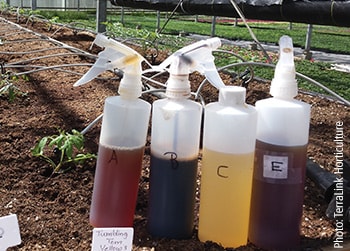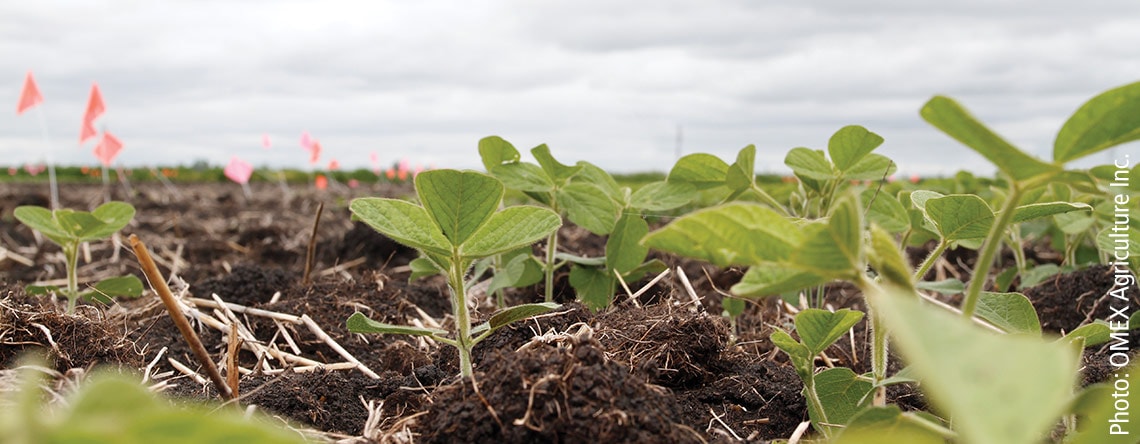Retailers can help their customers make informed decisions by testing for product efficacy.

When the Canadian Food Inspection Agency (CFIA) removed its efficacy testing requirements for new fertilizer products, it heralded a substantial change in the volume and variety of product options available to Canadian growers.
Effective April 1, 2013, the removal of efficacy testing requirements prior to registration made it much easier for fertilizer companies to bring supplemental and specialty products to market. According to Rigas Karamanos, senior agronomist at Koch Agronomic Services, like many decisions, this one came with both pros and cons.
“We no longer have to rely on a lengthy process,” says Karamanos. “The backlog of products waiting to be registered has dropped dramatically, and that is one very positive benefit.”
But, clearing the backlog also meant an influx of products that lacked verified efficacy claims entered the market, creating a new level of complexity for growers when it comes to selecting what products to use on their crops.
“While I still think companies should hold their products to a high standard, with no more industry standard growers can’t always be certain this is the case,” says Karamanos. “The responsibility of ensuring product efficacy has shifted from the manufacturer more to the end user. I tell farmers, ‘You’re doing the research now.’”
The responsibility of ensuring product efficacy has shifted from the manufacturer more to the end user. I tell farmers, ‘You’re doing the research now.’
Establishing Trust
Stan Loewen, president and CEO of TerraLink Horticulture, a crop input manufacturer and retailer based in Abbotsford, B.C., says that beyond even deciding if products live up to their claims, growers now have to decide if companies themselves are trustworthy.
“Instead of the fertilizer company having to prove efficacy before having their product registered, now the customer has to say, ‘Is this company I want to deal with trustworthy, or not?’ And they have to make up their mind on that,” Loewen says.
Rather than a challenge, this registration change has presented an opportunity for retailers to conduct their own efficacy testing on the products they stock. This will position their company as a trusted advisor by helping growers make informed purchase decisions, while demonstrating that they have the customer’s best
interests in mind.
“Conducting your own product efficacy testing will help your retail get a good reputation as a company that goes above and beyond, and that reputation can help bring business in,” says Loewen. “TerraLink won’t sell anything we can’t prove the efficacy of. We have our own quality assurance program and our own standards that we want to meet, regardless of the government requirements.”
Putting Products to the Test

Loewen says that for traditional NPK products, there’s no doubt they work. But when it comes to specialty fertilizer products, both the formulations TerraLink develops and those they stock from other manufacturers are put to the test in their research and development department.
“We put products through performance-based testing in field situations with farmers,” he says. “We test the new product against the grower’s standard practice. We like to do a side-by-side comparison, so we know whether the addition of the new product changes anything.”
Karamanos reminds retailers that when they are field testing, factors like extremely-localized soil quality can impact crop growth, making it appear as though a product was responsible for a desirable yield increase when it really had little to no effect. To illustrate this point, he tells the story of a time when he took an out-of-the-box approach during a field test.
“I once conducted 19 replicated trials with Dr. Don Flaten from the University of Manitoba, with two treatments, namely, a control and one where we threw two pennies in the air,” he says. “In one of the trials, we got a statistically significant yield increase of 43 per cent over the control. It could look like the yield increase came from throwing those two pennies, but obviously, something else was going on there.”
We’re used to being picky, and that’s a standard we feel the end user deserves.
To account for potential environmenal differences that can occur from field to field, Loewen says that TerraLink uses best practices that include testing soil, water and air quality before starting a field trial.
Loewen adds that each trial can have different measurables depending on the nature of the product, but that no product gets it easier than another. “We’re used to being picky, and that’s a standard we feel the end user deserves,” he says.
Communicating with Customers
Once testing is complete, harnessing the true value of product efficacy data comes from effectively communicating that information to growers. Both Karamanos and Loewen agree that growers tend to trust a product if they trust their sales representative, making them the ideal source to communicate with customers.

“As consumers, farmers are more informed than ever before, and they are looking for those research results,” says Karamanos. “But even more so than that, farmers trust the person they deal directly with. If they trust that person, they trust the product.”
Doug Grandel, western Saskatchewan territory manager with Omex Agriculture Inc. Canada (Omex), has experienced this first-hand with his grower customers. He says his long-time clients are more likely to take him at his word, but when it comes to building trust with new customers, having solid product data helps build his credibility.
“Data goes a long way to starting a relationship. Pretty quickly, producers are asking ‘Well, what have you got for data? What have you got to back up the claims you’re making?’” he says.
According to Grandel, it’s crucial that field representatives are equipped with the right kind of data and information to present during those conversations. He says multi-year data is always in high-demand, and that growers always want to know how the product performs under local conditions.
“One of the first questions a new customer asks is, ‘Do you have any farmers in my area who are already using your product, and what do they think about it?’” says Grandel. “That conversation is going to happen pretty early in the relationship.”
The better the answer, Grandel says the more likely it is the farmer will be willing to give a new product a try, and the better he feels about the recommendation. “One of the things I really like about working with Omex is access to data from different locations and crops over the years. That gives me confidence to recommend products to my customers.”
Karamanos also highlights localized research as one area that retailers can excel in. Even if products have been tested by manufacturers for efficacy, he says there is value in testing them locally, because what works in an environment like California might not work in Western Canada.

Bringing it All Together
According to Grandel, another key consideration when communicating research results and data is to put it in a context that growers can understand and relate to. This is where he says testimonials can play a key role to back up the data being presented, and recommends retailers take time to pick the best ones.
“Of course, you can’t rely on testimonials 100 per cent to sell your product, but they do play a big part; farmers believe farmers,” he says. “The best testimonials don’t feel scripted, they’re not pre-written. They come straight from the growers themselves and speak to their real experience.”
According to Grandel, the best way to bring all of these elements together for producers is the old-fashioned way: through one-on-one conversations.
“We have some information on our website, and we can communicate through tradeshows and presentations as well, but those one-on-one conversations are still the best way to get your message across,” he says.
Those one-on-one conversations are still the best way to get your message across.
“These days, the amount that gets spent on crop inputs on farms is astronomical,” he continues. “It’s a big decision for a grower to make. Having a personal relationship with that grower goes a long way.”
With more products available to growers than ever before and no efficacy standard to meet before products hit the market, retailers can help their customers feel confident in their investments by ensuring the products they sell are effective through research.
“As a company we have to be able to back the performance of the products that we sell,” says Karamanos. “This is a baseline that our customers deserve. It behooves us to do the research and to prove our products are working.”
Related Articles
- April 2024 issue of CAAR Communicator now available online The April issue of CAAR Communicator "I Think therefore AI AG" should arrive in your mailbox any day now. The issue welcomes new Executive Director Myrna Grahn who began her new role on March 25, 2024. The featur...
- AI & Ag A viewpoint on how artificial intelligence can positively impact the agricultural sector. By Andrew Joseph, Editor When it comes to AI, aka artificial intelligence, people either know all about it or they don’t. ...
- February 2024 issue of CAAR Communicator now available online The February issue of CAAR Communicator "I Love Ag" should be arriving in your mailbox. The feature article looks at brand marketing and standing out from the competition. The February issue of CAAR Communica...
- The winter 2023-2024 plans for CN and CPKC A look at some of the issues Canada’s Big-2 railroads are most concerned about and what they have planned for the winter of 2023-2024. by Andrew Joseph, Editor In our previous issue, we examined the 2023–24 Grain...
- Clearing the air on carbon tax Andrew Joseph, Editor Sometimes, people and governments toss out new words or phrases and expect everyone to follow along. Such is the case with carbon taxes. Most of us have a peripheral understanding of the conc...
 How to resolve AdBlock issue?
How to resolve AdBlock issue? 
Join the discussion...
You must be logged in as a CAAR member to comment.
Report
My comments